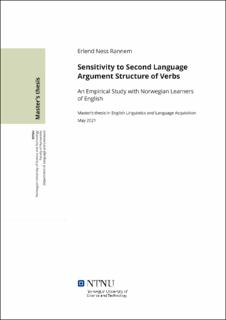| dc.description.abstract | Language users continuously predict upcoming information in their L1 by exploiting information encoded in verbs’ lexical entries. As such, native speakers are sensitive to the argument structure of verbs. But what happens when the linguistic context is shifted to a non-native language? This thesis tests whether and to what extent predictive language processing occurs in an L2, and investigates how the factors of verb constraint and verb frequency influence in this regard. 54 native Norwegian speakers of English responded to two language tests. One sentence completion test where sentences were grouped by different levels of constraint (most-, moderately-, and least constrained verbs) and frequency (high- and low frequency verbs); and one vocabulary test. The findings suggest that every participant displayed some level of sensitivity, irrespective of one’s proficiency; instead, the relationship between proficiency and sensitivity held only a deterministic role in the most constraining contexts. In addition, the following constraint- and frequency effects were observed: more target response overlaps and less unique responses were elicited the more constraining a verb was (most > moderately > least) and the less frequent a verb was (low > high). | |
